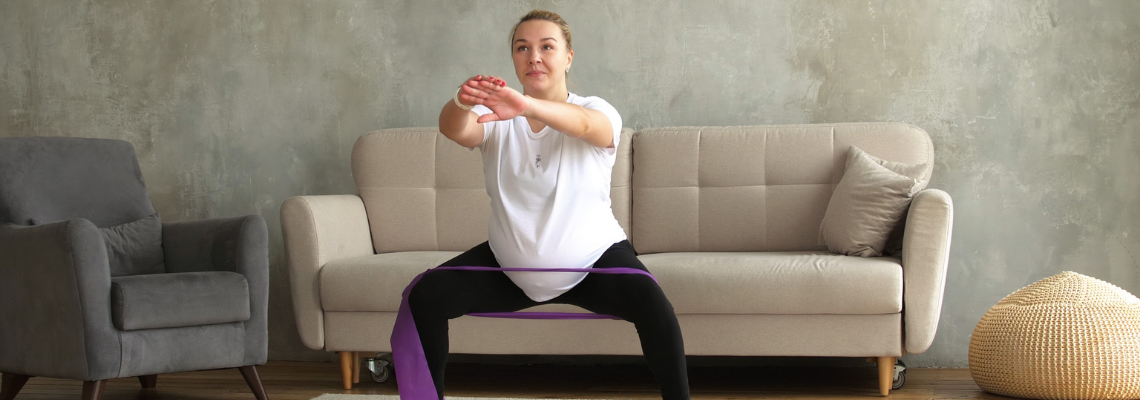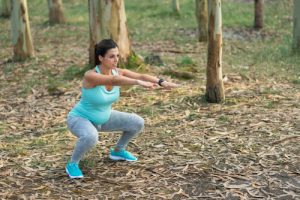
Squats are common exercises that are effective in building lower body strength and are especially beneficial to pregnant women.
There is a wide range of squat variations. Some can be done without equipment, while others require equipment such as kettlebells, dumbbells or resistance bands.
Why Squats are Important
Squat variations have a couple of benefits to pregnant women. Squat variations can be incorporated in exercise regimens of pregnant women to prepare them for labor and tone the body after delivery. Squatting during labor goes a long way in assisting the opening of the pelvis. The importance of squats to pregnant women cannot be understated. Generally, squats target the hamstrings, hips, quads and glutes.
Surprisingly, we perform several squat movements during the day. Every time we bend to pick up something off the ground, sit down or stand up, we perform squats unknowingly. Being able to handle daily tasks is essential. It is even more crucial during pregnancy.
Expectant mothers should incorporate squat variations into their routine fitness programs to prepare their bodies for labor and delivery. Here are the reasons why pregnant women should perform squats.
- Squats brace the glutes, which helps balance the pelvis and minimize the occurrence of lower back pain.
- Squats foster balance and coordination to shift the center of gravity as the belly expands.
- Like other exercises, squat variations increase heart rate and maintain a healthy cardiovascular system.
- Squats nourish the lower body and improve mobility in the hips to attain the squat position that will help her overcome contractions during labor.
Squat Variations Based on Trimester
 First Trimester
First Trimester
Your body composition starts to change in the first 14 weeks of pregnancy. During this time, you should strive to perform squats regularly to strengthen your lower body. Besides helping to support the lower body, squats will help pregnant women to shed excessive weight.
When doing squats during the first trimester, stand with your feet hip-width apart and strive to root into the floor by your heels, big toes and the external of your feet. Here are the types of squats you should perform during the first trimester of pregnancy.
Box Squats
While performing this variation, a pregnant woman should stand in front of a chair and bend the knees to sit down fully. She should then stand up straight and avoid leaning forward. This variation engages the glutes through pressing on the heels.
Goblet Squats
This variation enhances the thoracic position. Preferably, it should be done with a box or any form of a load.
Barbell Back Squats
While performing the back squat, you can increase the external weight. A heavier weight helps to build strength and endurance in the lower body. This goes a long way in preparing your body for additional weight during the second and third trimesters.
Second Trimester
From the 14th to 28th week, the belly protrudes and can’t be mistaken for something else. Mothers should be careful during this period, especially when exercising. While doing squats, women should not add a weighty external load all at once. During this period, you should improve the first trimester squats.
Offset Kettlebell Squats
With extra baby weight and the external weight loaded in one arm, you will be forced to engage your glutes to keep squat form.
 Third Trimester
Third Trimester
The squat variations during the last trimester should be less vigorous than in the previous trimesters. The baby weight has increased, and thus you should reduce the external load. At this stage, you should strive to improve hip mobility, balance coordination and endurance to get ready for labor and delivery.
During the third trimester, you can use the goblet, assisted or unassisted box squats, barbell back and sumo squats. As you get close to labor, increase repetitions and reduce external load. The primary goal of squats in this trimester is to enhance endurance in preparation for delivery.
Sumo squat
This type of squat involves holding the external load at the center with your legs apart. The variation does well in strengthening mobility in the hips. You don’t need a heavy load for the variation to be effective.
Additionally, exercise in a well-ventilated room and avoid hot and frigid environments. Also, stay well hydrated and include more extended rest periods.


